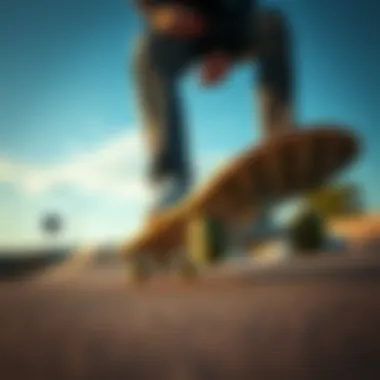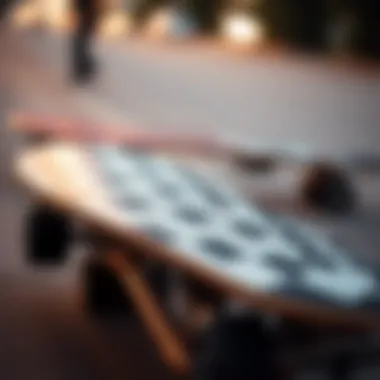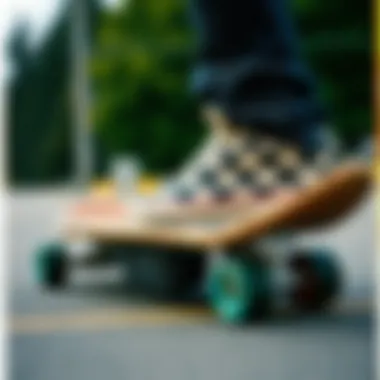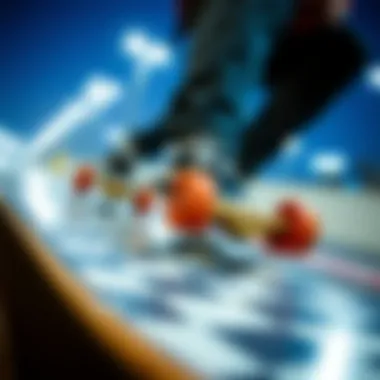Exploring the Aesthetic and Functional Aspects of Checkered Skateboards


Intro
Skateboarding has always been more than just a way to get from point A to B; it's a form of expression, a lifestyle, and an art. Among the myriad ways to express identity through skateboards, the checkered design stands out for its powerful aesthetic and cultural weight. The visual appeal of checkered skateboards is not just skin deep; these designs have roots in history and symbolize a community that values creativity and authenticity.
This article aims to delve into the intricate relationship between checkered skateboards and the various elements involved in skateboarding culture. From the flow of graphic design to its functional contributions in performance, we will explore how checkered patterns resonate with skaters’ identities and experiences.
One might wonder why the checkered pattern, in particular, has made its mark. Perhaps its dynamic nature mirrors the feelings of freedom and excitement that skating inspires. Or maybe it’s the way it stands out in an environment often marked by conformity. Whatever the reason, the influence of checkered patterns in skateboarding culture deserves a thoughtful examination.
Prelude to Checkered Skateboards
Checkered skateboards represent more than just a trend; they embody a rich visual language that has seeped into the core of skate culture. The appeal of these boards is multi-dimensional, intertwining aesthetics and functionality. This section will delve into the essence of what makes checkered skateboards a staple choice for many, particularly amongst skaters who value both the art and utility of their gear.
The bold patterns are instantly recognizable, capturing the attention of both enthusiasts and newcomers alike. These lively designs evoke a sense of nostalgia and energy, making them a canvas that reflects individual personalities as well as broader skate culture. The versatility of checkered patterns also plays a critical role. Originating from racing and pop culture, checkered designs have been reimagined through various styles over the years, allowing each new generation of skaters to leave their mark.
Exploring the Visual Identity
The visual identity of checkered skateboards is rooted deep within the fabric of skateboarding subculture. With a background that blends punk rock aesthetics, retro racing motifs, and urban street art, checkered patterns serve as both a statement and a connection to history. Their stark contrasts create an immediate impact, making any board grab attention on both the ramp and the street.
Many skaters choose checkered designs not solely for their look, but for what they represent — defiance, individuality, and a nod to an illustrious past. For instance, the iconic black and white squares can invoke thoughts of the rebellious spirit seen in films like "Easy Rider" or the fast-paced excitement of motorsport. This visual identity is not just about looking good; it resonates with those who dare to be different and who embrace the culture that surrounds them.
The Evolution of Design Trends
The evolution of design trends in skateboarding has been anything but linear. From the rudimentary graphics of early skateboards to the sharp, distinctive styles seen today, each era brings its own flavor. Checkered patterns have evolved in tandem, absorbing influences from various art movements and social changes. In the early days, skateboards were often painted with crude designs; however, as the sport gained traction, so did its aesthetic.
With the rise of digital technology, skaters began to see an explosion of creativity in graphics and patterns. Checkered designs transitioned from mere overlays to intricate artwork that tells a story. The use of colors and materials has expanded as well, with boards now showcasing a spectrum of checkered patterns in vibrant hues, merging traditional style with contemporary flair.
"Checkered skateboards are not just about rides; they articulate a rich history and personal expression — they’re like wearable art on wheels."
This continuous evolution reflects how skaters adapt to trends while staying rooted in their heritage. Today, checkered skateboards stand as a testament to how design can influence not just appearance, but also community identity. As each generation of skaters embraces this style, they contribute to a living tapestry of creativity and self-expression that permeates the sport.
Historical Context
Understanding the historical context of checkered skateboards provides rich insight into not just their design but also their significance within the skateboarding culture. The evolution of this pattern is intertwined with various artistic movements and personal expressions over the decades. This segment sheds light on how checkered designs emerged, the artists who popularized them, and their significance, offering a comprehensive backdrop against which today's aesthetic flourishes.
The Origins of Skateboard Art
Skateboard art, particularly the checkered pattern, can be traced back to the mid-20th century when skateboards transformed from mere wooden planks into canvases for self-expression. The sport blossomed in California during the 1970s, coinciding with the rise of surf culture. Skaters began to personalize their boards, favoring vivid colors and bold designs.
The checkered pattern specifically symbolizes speed and movement, which may explain its magnetic pull within this subculture. The adoption of this motif can be seen as skaters were looking to reflect their rebellious spirit and dynamic lifestyle. It wasn’t just about having a board—it was about showcasing individuality.
"The checkered board is like a badge of honor for many skaters; it tells a story of freedom, rebellion, and art."
During the late 20th century, more artists and designers engaged with skateboard graphics, further embedding checkered patterns into the visual lexicon of skate culture. The works of pioneers like Jim Phillips and Steve Caballero not only celebrated this aesthetic but elevated skate art to recognized artistry, fully integrating it into the culture.
Key Figures in Checkered Design
Certain individuals have been instrumental in molding the checkered skateboard aesthetic, and their influence is felt in modern designs. Among them, Tony Hawk stands out—not only for his amazing skating skills but also for his branding that invariably incorporated checkered designs in various merchandise.


Another vital figure is Chris Miller, who brought a unique flair that married technical skating with artistic designs, paving pathways that future generations would follow. These personalities not only rode their boards; they splashed their very identities across skate culture, particularly with checkered patterns.
Moreover, the collaboration between skateboard companies and graphic designers has allowed various collections to flourish, such as Vans, whose iconic checkered shoes have complemented the boards beautifully. This cross-pollination of fashion and skateboarding further cements the importance of the checkered design as both a symbol and a functional element in skating.
In summary, the narrative around checkered skateboards is as complex as the design itself. It envelops historical origins, intersecting with key figures that shaped not just the skateboards but also the community and culture surrounding them. By understanding the historical elements, one appreciates not only the aesthetics but also the deeper meanings tied to identity and self-expression.
Material and Construction
When it comes to skateboards, the materials and construction techniques are not just afterthoughts; they play a pivotal role in shaping the overall experience of riding. From seasoned skaters to newcomers, understanding how checkered skateboards are built can inform choices that affect performance, durability, and aesthetics. Each component—from the deck to the grip tape—contributes to both the look and the ride of the board, creating a blend of style and function.
Common Materials Used
The backbone of any skateboard lies in its materials. Generally, checkered skateboards are primarily made from hardwoods, like maple or birch, which provide necessary resilience and flexibility. The poplar wood is a popular option too—it's lightweight, making it easier to perform tricks without sacrificing strength.
Moreover, the decal process, where checkered patterns come into play, often involves high-quality, water-resistant vinyl. This ensures that the vibrant patterns endure wear and tear during those gnarly sessions at the skate park. In some higher-end boards, carbon fiber composites also enter the mix, providing a unique combination of stiffness and lightness. Here’s a quick breakdown of materials that are commonly employed:
- Maple: Known for its durability and responsiveness.
- Birch: Offers a good flex and strength, often preferred for trick boards.
- Poplar: Lightweight, ideal for beginners.
- Carbon Fiber: Lightweight and stiff, often used in premium models.
- Vinyl Decals: Ensure long-lasting graphics that resist fading.
Techniques in Manufacturing
Achieving that perfect checkered pattern on a skateboard isn't merely about sticking on a decal. Several techniques are used to ensure that the aesthetic aligns flawlessly with functionality. Firstly, there’s the screen printing method, where ink is pressed through a mesh stencil onto the board. This technique allows for vibrant colors that don’t fade quickly.
Alternatively, some boards utilize hydrographic printing. This allows for complex patterns to wrap around curves seamlessly, offering a more immersive checkered look. Different manufacturers invest heavily in proprietary techniques, yet the end goal remains the same—combining beauty with unyielding quality.
Customization Options for Checkered Boards
One of the most appealing factors of checkered skateboards is the opportunity for personalization. Skaters can take a factory model and make it their own. Customization can range from selecting specific color schemes to including personal graphics alongside the traditional checkered design.
For instance, some skateboard brands allow customers to choose their color palette for the checkers or even add their name or a graphic that represents their skater identity. Griptape is another avenue where personalization can shine, with various textures and colors available to match or contrast with the deck design. Options include:
- Different Size Decks: Catering to various widths suited for tricks or cruising.
- Custom Griptape Designs: Tailored to reflect personal style while ensuring grip.
- Graphic Add-Ons: Allowing for unique elements that say something about the rider.
In essence, the interplay of materials and construction techniques in checkered skateboards illustrates a delicate balance between aesthetic appeal and practical performance. By understanding these elements, skaters can make more informed decisions that enhance their riding experience, reflecting their personal style as they carve through the streets or the skate parks.
"A skateboard is not just a means of transport; it is a canvas for self-expression."
For more about skateboard materials and customization, check out resources such as Wikipedia and Reddit's skateboarding community.
Cultural Impact
The cultural impact of checkered skateboards extends far beyond their visual aesthetics. These boards symbolize a unique fusion of art, identity, and community that has evolved within the skateboarding culture. The checkered pattern has become emblematic of a rebellious spirit, invoking feelings of nostalgia while simultaneously pushing forward the boundaries of modern design.
Checkered Patterns in Skateboarding Subculture
Checkered patterns have carved a niche in skateboarding subculture, often associated with the quintessential street style that defines these communities. Their origins trace back to the bold graphics typical of the late 20th-century skate culture, emphasizing individuality and non-conformity.
- Artistic Representation: Artists and skaters alike have leveraged this pattern to express their personal stories, cementing the relationship between skateboarding and artistic freedom. This correlation amplifies the idea that every skateboard becomes a canvas, showcasing not just a design but a narrative.
- Community Bonding: The presence of checkered boards can foster connections among skaters, creating a shared identity and experience. Events like skate showcases, gatherings, and competitions often feature these designs prominently, allowing skaters to resonate with a communal sense of pride and belonging.


This shared appreciation for checkered patterns facilitates an understanding of its deeper meaning within the community—a fabric woven from countless stories and experiences.
Influence on Fashion and Life Style
Checkered skateboards have transcended their utilitarian role, influencing not just the skateboarding world but also the broader fashion landscape. The visual appeal of checkered designs has penetrated the realm of clothing and accessories, often appearing on everything from snapbacks to sneakers. This has led to several noteworthy phenomena:
- Cross-Pollination of Trends: High fashion brands have adopted checkered patterns, integrating them into runway looks and mainstream apparel. This intersection signals the acceptance of skate culture into high-style arenas, where young designers and traditional fashion houses converge.
- Streetwear Influence: The trend has further popularized the streetwear movement, wherein checkered patterns dominate collections that speak to the younger generation's desire for comfort and expression. Brands regularly feature this motif in their designs, blurring the lines between skater culture and everyday wear.
These trends manifest an admiration for the freedom expressed through skateboarding, while simultaneously allowing enthusiasts to showcase their commitment to the lifestyle.
Public Perception and Symbolism
The public perception of checkered skateboards plays a critical role in establishing their cultural significance. While many see them primarily as graphic designs, the checkered pattern embodies a deeper symbolism, often reflecting the values of grit, resilience, and creativity.
- Cultural Reference Points: Popular media also portrays skateboards with checkered patterns as symbols of youth rebellion, often tying them to themes of freedom and defiance. This portrayal in films, music videos, and social media amplifies their status within popular culture, enhancing their appeal.
- Symbol of Individuality: In a world increasingly focused on conformity, checkered skateboards represent a statement of individuality. Skaters who choose these designs take a stand against conventional norms, making bold choices that resonate beyond the skate parks.
"In every checkered pattern lies a story—a tale of passion, rebellion, and the relentless pursuit of identity in a world that often tries to define us."
Understanding the cultural impact of checkered skateboards unveils the layers of meaning these designs hold, further emphasizing their ongoing relevance within and beyond the skateboarding culture.
Performance Aspects
When it comes to the world of skateboarding, performance is as crucial as aesthetics. The interplay between a skateboard's design and its functionality can greatly influence a skater's experience. In the case of checkered skateboards, this balance becomes even more significant. Not only do they manifest a strong visual identity, but they also impact the way a skater maneuvers and interacts with their environment. The distinct checkered patterns present on these boards offer more than style; they also play a role in grip, stability, and confidence on the board.
Does Design Influence Performance?
The question of whether design truly influences performance is worth exploring. At first glance, some might view the checkered pattern as just a superficial detail, but there’s more beneath the surface. A board's design can affect various performance metrics such as grip and aerodynamics. For instance, the visuals on a checkered skateboard can enhance a skater's footing.
- Grip: The contrast in colors not only adds to the aesthetic but also creates a sensation of enhanced grip. The optical illusion of depth caused by the checkerboard pattern can make skaters feel more secure in their stance, potentially reducing slips during tricks.
- Confidence: Furthermore, a skateboard that looks sharp and stands out can bolster a skater's confidence. If a rider feels good about their board, they are likely to attempt more challenging tricks.
In that sense, design does indeed influence performance, not just mechanically but psychologically as well. If a skater enjoys their board’s look, it can positively impact their performance on it.
Balance Between Aesthetics and Function
Finding the sweet spot between aesthetics and function can be tricky in the skateboard industry. It isn’t simply about vibrant colors or trends; it’s about ensuring that the design elements enhance the practical aspects of the board.
- Durability vs. Design: One challenge faced by manufacturers is to create visually appealing boards that maintain structural integrity. Checkered designs may require specific materials and applications which can affect how well the board stands up to wear and tear.
- Visual Distraction: Similarly, while the visuals are important, they should not distract from performance. Skaters need to ensure that any flashy graphics don’t interfere with their focus when landing tricks.
- Personal Preference: Ultimately, personal preference plays a significant role in this balance. What works for one skater might not prove effective for another. Some skaters are focused on high performance, while others lean more towards artistic expression and style.
Effective communication among skaters, manufacturers, and designers is vital in bridging the gap between impressive visuals and outstanding performance.
The right checkered skateboard can lead to enhanced performance while still reflecting a skater's style — a true symphony of form and function.
Personal Identity and Expression
In the world of skateboarding, the very act of riding can serve as a profound form of personal expression. Checkered skateboards, with their bold patterns and striking visuals, offer skaters an opportunity to showcase their unique style and individuality. Just like a painter selecting their colors, choosing a skateboard becomes a statement of identity. This choice often reflects one's personality, values, and even aspirations, making the skateboard more than just a ride; it becomes an extension of the self.
Significance of Custom Styles


Customizing a skateboard allows skaters to declare their presence in a community that values uniqueness. The significance of custom styles can be seen through multiple lenses:
- Visual Identity: A customized checkered pattern can turn heads, projecting an image that resonates with one’s personality. For instance, a bright yellow and black checkerboard design can imply boldness and creativity.
- Emotional Connection: Many skaters choose designs that evoke certain feelings or memories. This personal connection promotes a deeper bond with their skateboard.
- Social Recognition: A standout design serves as a social badge of honor. Friends and fellow skaters recognize and respect the creativity behind unique styles, making it a conversation starter.
Customization does not stop at graphics; it extends to deck shapes, grip tape patterns, and even wheel colors. Such bespoke adjustments allow the skater to craft a board that feels genuine and personal.
Developing a Personal Brand through Skateboard Choice
In recent years, skateboards have evolved into symbols of personal branding. The choice of a checkered board, in particular, serves a dual purpose: it satisfies aesthetic preferences while also aiding in creating a recognizable identity. Here’s how a skateboard can contribute to one’s personal brand:
- Distinct Visual Language: A unique checkered design can communicate a skater's taste and style without uttering a word. It’s an immediate visual cue that can relate to others who share a similar aesthetic.
- Reputation Building: Consistent style can lead to a reputation within the skate community. An individual known for their distinctive checkered board design may become a local icon, influencing others and shaping trends.
- Online Presence: Social media platforms like Instagram and Reddit allow skaters to showcase their boards to a broader audience. A striking checkerboard design can lead to increased engagement, attracting followers who appreciate their style.
When a skater intentionally curates their choice of board, they consciously craft an image that not only represents their unique identity but also boosts their influence within various skateboarding circles.
Personal identity in skateboarding blends artistry with functionality, transforming boards into canvases that reflect the skater's essence.
The Future of Checkered Skateboards
As skateboarding continues to evolve, the future of checkered skateboards holds untold possibilities. This topic is crucial for understanding how aesthetics, functionality, and cultural relevance will adapt in the upcoming years. The designs we see today offer insights into current trends, while their anticipated evolution will reveal the changing tastes of skateboarders and the broader community. One significant aspect is how checkered patterns not only contribute to individual style but also capture the spirit of skating as a whole.
Emerging Trends in Design
The design of checkered skateboards is not static; it's a canvas that reflects shifting styles and preferences. Recent trends indicate a blending of aesthetics and functionality. For instance, we see a rise in skateboards that incorporate digital technology, leading to customizable graphics and designs that can change on the fly. This could allow skaters to renew their board’s look without needing a complete overhaul.
On the more traditional front, retro vibes are making a comeback. Classic checkered patterns with contemporary twists are becoming popular. Some brands are experimenting with gradients or even luminous colors to appeal to a younger audience. This curiosity for unique aesthetics means an endless array of designs will forge a more vibrant landscape within skate culture. From simple black and white to explosive colors, each board tells a story about its rider.
Different Types of Checkered Patterns
- Traditional Black and White: Grounded, classic, always in style.
- Color Variants: Adding a splash of personality with bold colors.
- Gradient or Ombre Styles: Evoking an air of modernity while honoring the past.
These designs are not merely about appearance; they reflect the personal identity of skaters as well. A board’s aesthetics can speak volumes about who the skater is, their circle, and their place within the skating community. Designers are acutely aware of this and will undoubtedly continue to innovate, helping the checkered pattern remain relevant.
Sustainability in Skateboarding Gear
Another fundamental aspect guiding the future of checkered skateboards is sustainability. As awareness of environmental issues grows, skaters are shifting focus toward eco-friendly materials and practices. Manufacturers are sourcing sustainable woods, like bamboo, and looking into vegan-friendly options for grips and finishes.
The combination of checkered designs with sustainable materials creates not only an attractive product, but also resonates deeply with the values of a modern skater. For instance, a skateboard made from recycled materials and sporting a trendy checkered design can really stand out on the rink!
Considerations about sustainability might include:
- Material Choices: Swapping out traditional materials for sustainable alternatives can help lessen environmental impact.
- Renewable Production Processes: Companies are striving to minimize waste in their manufacturing processes.
- Longevity Over Trends: Many skaters are opting for quality gear that lasts rather than succumbing to short-lived fads.
By integrating sustainability with artistic expression, the checkered skateboard is positioned not only as a tool for transportation and fun, but also as an emblem of environmental consciousness.
Culmination
In the world of skateboarding, checkered skateboards stand out not just for their eye-catching patterns but for their deeper implications in both aesthetics and functionality. The checkered design encapsulates a rich history and a cultural significance that resonates with skaters from various backgrounds. Throughout this article, key insights have emerged that underline the importance of this topic.
- Visual and Cultural Identity: The checkered pattern holds a unique place in skate culture, often serving as a badge of identity among skaters. It reflects individual style while simultaneously connecting riders to the larger community.
- Material and Construction Considerations: The choice of materials influences not only durability but also the overall feel of the board. Knowing the characteristics of different woods and composites can enhance the skater’s experience, providing both aesthetic appeal and functional performance.
- Trends and Future Directions: Emerging designs are increasingly leaning towards sustainable materials, bridging the gap between personal style and environmental responsibility. As skaters become more environmentally conscious, it’s crucial for manufacturers to adapt while maintaining the classic charm of checkered patterns.
- Personal Expression: How skaters choose their boards reflects their journey and personality. The checkered skateboard serves as a canvas for individuality, contributing to the evolution of personal branding in skateboarding.
- Balance of Form and Function: The intricate relationship between style and practicality means that aesthetics must never compromise performance. Finding this balance is essential for both enjoyment and safety in skating.
In summary, the checkered skateboard is a perfect illustration of how aesthetic considerations can align with functional requirements. As skaters continue to push boundaries in both art and sport, understanding these dynamics will enrich their experience and engagement with their boards, making checkered designs not just a trend but a vital part of skateboarding history.
"A skateboard is more than just a ride; it’s an expression of self, an art form that moves with you through life."
To dive deeper into this topic, resources such as Wikipedia, Encyclopedia Britannica, and Reddit Skateboarding Community can offer further insights and discussions. Skaters, hobbyists, and instructors alike can benefit from exploring these connections in their journey with checkered skateboards.







